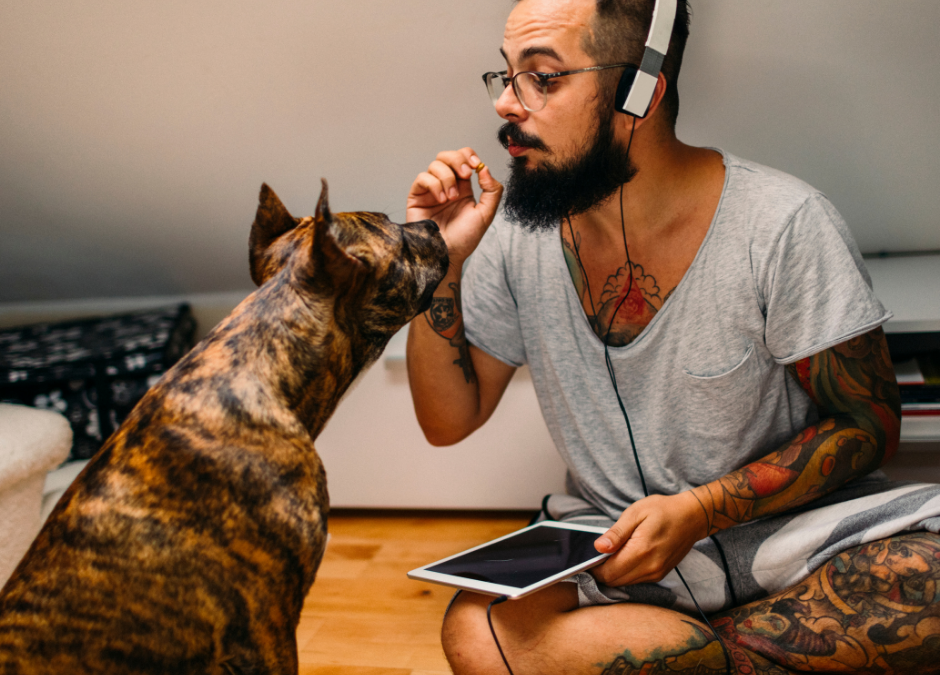Dog Language: How to Communicate with Your Dog
Sometimes it can be hard to figure out how to communicate with your dog since we don’t speak the same language. But that doesn’t mean we can’t communicate with them! Dogs are incredibly smart animals and when you learn some of the basics for how to communicate with your dog, it strengthens your bond with them and makes training much easier.
The primary ways you can communicate include tone of voice, clear verbal commands, leash commands, and body language.
Communicate: Tone of voice
Dogs will respond to the tone of your voice even more than your actual words much of the time. Although dogs can learn more than 165 words (depending on breed and intensity of training), they respond very well to tone of voice. If you’re eager to get their attention, try speaking to them in a high-pitched, excited voice. Dogs will often respond more quickly to women and young children for this reason, as their voices are naturally higher, and some additional training may be needed for your dog to respond to a lower, deeper voice.
Also keep in mind that if you’re trying to calm an excited or anxious dog, you want to speak in soft, soothing tones. Yelling at a dog generally isn’t helpful, as they don’t understand why you’re angry. The better approach is to use a firm but even tone of voice to redirect their behavior.
Communicate: Clear verbal commands
Most dogs know the word “no,” but they don’t necessarily understand why you’re saying it, especially if you’re angry. They might understand your meaning if you catch them in the act of eating your shoe or chewing on something else, but even then, anger doesn’t work as a functional training tool. A good alternative to “no” would be a different command that they already understand. If they’re excited about something or barking at that squirrel outside the window, using a clear verbal command of “lay down” will work better than “no.” If they jump on visitors to your home, tell them to “sit.” This will stop the negative behavior by giving them a clear and concise command that they can understand.
Communicate: Nonverbal commands
When learning how to communicate with your dog, there are a few different approaches to nonverbal commands, including leash commands and hand signals.
Leash training is an important part of dog ownership, as it allows you to walk your dog calmly and peacefully. Dogs need exercise (and it’s good for their humans too!), but a daily walk shouldn’t be a struggle for control. With consistent training, your dog will understand that a gentle tug on the leash while walking means slow down or an upward pull as you come to a stop means to sit.
Hand signals are another way to communicate with your dog, and they’re often learned in conjunction with verbal commands initially. If you pair pointing at the floor with a verbal command of “lay down,” soon enough simply pointing at the floor will be enough for your dog to understand the command. As with verbal commands, it’s important to be clear and consistent with your nonverbal commands as well.
Communicate: Body language
The final tip we have on how to communicate with your dog is body language, which includes both yours and theirs. Have you ever noticed your dog’s body language? How their ears droop and their tail is still when they’re sad? Or how they seem to have very expressive eyes? Or how they tuck their ears and their tail when they are nervous or scared?
Just as you can read a dog’s body language, they can also read yours. When you’re having a bad day and your dog sticks close to your side and leans into you, they’re reading your body language and can tell that you’re upset. This is their way of trying to comfort you, but it also means they can pick up on your anxiety when you tighten the leash before passing another dog on a walk.
Body language is important when working with an anxious dog or meeting a new dog for the first time. Our natural approach as humans is to learn forward and extend a hand, but this can be seen as aggressive body language from the dog’s perspective. The better approach is to sit or to stand at a slight angle and let the dog come to you first.
Communicate with Your Dog: Putting it into practice
Dogs will form a strong bond with a kind and loving owner, and learning how to communicate with your dog is an important part of that bond. As with any communication, keep in mind that it’s a two-way effort for you to both communicate clearly and learn to understand how your dog is communicating with you.
If you need help with learning the basics of how to communicate with your dog, get in touch with our team to schedule an appointment.

